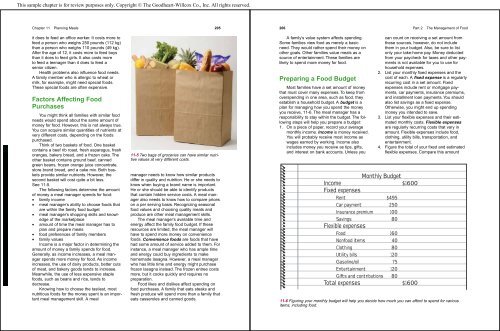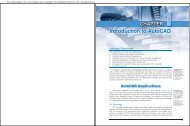Planning Meals - Goodheart-Willcox
Planning Meals - Goodheart-Willcox
Planning Meals - Goodheart-Willcox
Create successful ePaper yourself
Turn your PDF publications into a flip-book with our unique Google optimized e-Paper software.
This sample chapter is for review purposes only. Copyright © The <strong>Goodheart</strong>-<strong>Willcox</strong> Co., Inc. All rights reserved.<br />
Chapter 11 <strong>Planning</strong> <strong>Meals</strong> 205<br />
it does to feed an office worker. It costs more to<br />
feed a person who weighs 250 pounds (112 kg)<br />
than a person who weighs 110 pounds (49 kg).<br />
After the age of 12, it costs more to feed boys<br />
than it does to feed girls. It also costs more<br />
to feed a teenager than it does to feed a<br />
senior citizen.<br />
Health problems also influence food needs.<br />
A family member who is allergic to wheat or<br />
milk, for example, might need special foods.<br />
These special foods are often expensive.<br />
Factors Affecting Food<br />
Purchases<br />
You might think all families with similar food<br />
needs would spend about the same amount of<br />
money for food. However, this is not always true.<br />
You can acquire similar quantities of nutrients at<br />
very different costs, depending on the foods<br />
purchased.<br />
Think of two baskets of food. One basket<br />
contains a beef rib roast, fresh asparagus, fresh<br />
oranges, bakery bread, and a frozen cake. The<br />
other basket contains ground beef, canned<br />
green beans, frozen orange juice concentrate,<br />
store brand bread, and a cake mix. Both baskets<br />
provide similar nutrients. However, the<br />
second basket will cost quite a bit less.<br />
See 11-5.<br />
The following factors determine the amount<br />
of money a meal manager spends for food:<br />
• family income<br />
• meal manager’s ability to choose foods that<br />
are within the family food budget<br />
• meal manager’s shopping skills and knowledge<br />
of the marketplace<br />
• amount of time the meal manager has to<br />
plan and prepare meals<br />
• food preferences of family members<br />
• family values<br />
Income is a major factor in determining the<br />
amount of money a family spends for food.<br />
Generally, as income increases, a meal manager<br />
spends more money for food. As income<br />
increases, the use of dairy products, better cuts<br />
of meat, and bakery goods tends to increase.<br />
Meanwhile, the use of less expensive staple<br />
foods, such as beans and rice, tends to<br />
decrease.<br />
Knowing how to choose the tastiest, most<br />
nutritious foods for the money spent is an important<br />
meal management skill. A meal<br />
11-5 Two bags of groceries can have similar nutritive<br />
values at very different costs.<br />
manager needs to know how similar products<br />
differ in quality and nutrition. He or she needs to<br />
know when buying a brand name is important.<br />
He or she should be able to identify products<br />
that contain hidden service costs. A meal manager<br />
also needs to know how to compare prices<br />
on a per serving basis. Recognizing seasonal<br />
food values and choosing quality meats and<br />
produce are other meal management skills.<br />
The meal manager’s available time and<br />
energy affect the family food budget. If these<br />
resources are limited, the meal manager will<br />
have to spend more money on convenience<br />
foods. Convenience foods are foods that have<br />
had some amount of service added to them. For<br />
instance, a meal manager who has ample time<br />
and energy could buy ingredients to make<br />
homemade lasagna. However, a meal manager<br />
who has little time and energy might purchase<br />
frozen lasagna instead. The frozen entree costs<br />
more, but it cooks quickly and requires no<br />
preparation.<br />
Food likes and dislikes affect spending on<br />
food purchases. A family that eats steaks and<br />
fresh produce will spend more than a family that<br />
eats casseroles and canned goods.<br />
206 Part 2 The Management of Food<br />
A family’s value system affects spending.<br />
Some families view food as merely a basic<br />
need. They would rather spend their money on<br />
other goals. Other families value meals as a<br />
source of entertainment. These families are<br />
likely to spend more money for food.<br />
Preparing a Food Budget<br />
Most families have a set amount of money<br />
that must cover many expenses. To keep from<br />
overspending in one area, such as food, they<br />
establish a household budget. A budget is a<br />
plan for managing how you spend the money<br />
you receive, 11-6. The meal manager has a<br />
responsibility to stay within the budget. The following<br />
steps will help you prepare a budget:<br />
1. On a piece of paper, record your average<br />
monthly income. Income is money received.<br />
You will probably receive most income as<br />
wages earned by working. Income also<br />
includes money you receive as tips, gifts,<br />
and interest on bank accounts. Unless you<br />
Monthly Budget<br />
Income $1600<br />
Fixed expenses<br />
Rent $495<br />
Car payment 250<br />
Insurance premium 100<br />
Savings 80<br />
Flexible expenses<br />
Food 160<br />
Nonfood items 40<br />
Clothing 80<br />
Utility bills 120<br />
Gasoline/oil 75<br />
Entertainment 120<br />
Gifts and contributions 80<br />
Total expenses $1600<br />
can count on receiving a set amount from<br />
these sources, however, do not include<br />
them in your budget. Also, be sure to list<br />
only your take-home pay. Money deducted<br />
from your paycheck for taxes and other payments<br />
is not available for you to use for<br />
household expenses.<br />
2. List your monthly fixed expenses and the<br />
cost of each. A fixed expense is a regularly<br />
recurring cost in a set amount. Fixed<br />
expenses include rent or mortgage payments,<br />
car payments, insurance premiums,<br />
and installment loan payments. You should<br />
also list savings as a fixed expense.<br />
Otherwise, you might end up spending<br />
money you intended to save.<br />
3. List your flexible expenses and their estimated<br />
monthly costs. Flexible expenses<br />
are regularly recurring costs that vary in<br />
amount. Flexible expenses include food,<br />
clothing, utility bills, transportation, and<br />
entertainment.<br />
4. Figure the total of your fixed and estimated<br />
flexible expenses. Compare this amount<br />
11-6 Figuring your monthly budget will help you decide how much you can afford to spend for various<br />
items, including food.

















